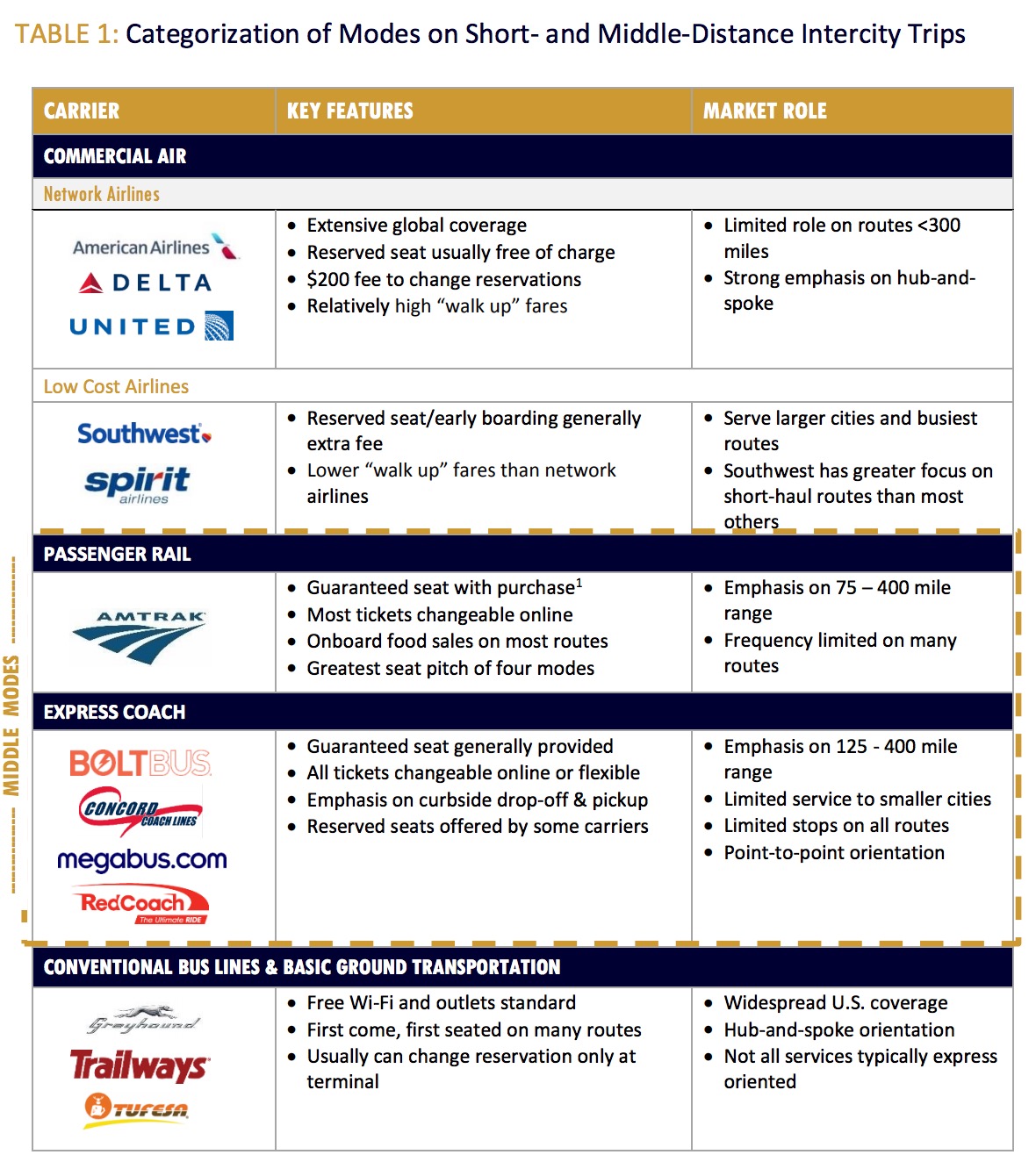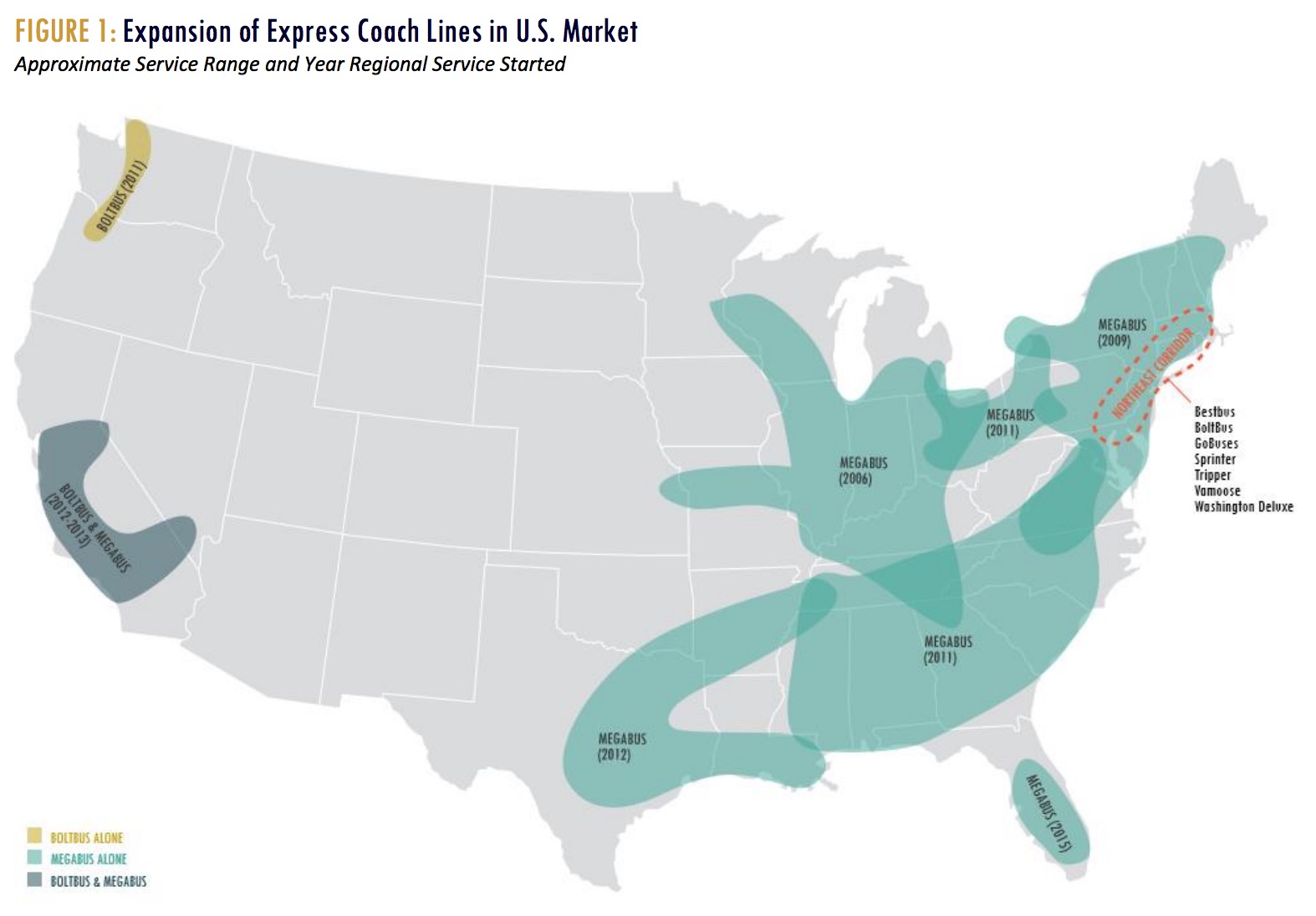CHADDICK INSTITUTE FOR METROPOLITAN DEVELOPMENT
DEPAUL UNIVERSITY
Evaluating Recent Setbacks in Amtrak and Intercity Bus Travel & Service Expansion During an Era of Lower Cost Fuel
Abstract
 Gradual expansions to the express coach and rail system between 2006 and 2015 provided millions of Americans new alternatives to private automobile travel in intercity trips. These services, provided by Amtrak, BoltBus, Megabus, and other carriers, along with ambitious plans for high-speed rail service, raised hopes that the country was on the cusp of creating a more balanced transportation system.
Gradual expansions to the express coach and rail system between 2006 and 2015 provided millions of Americans new alternatives to private automobile travel in intercity trips. These services, provided by Amtrak, BoltBus, Megabus, and other carriers, along with ambitious plans for high-speed rail service, raised hopes that the country was on the cusp of creating a more balanced transportation system.
However, these travel modes have, as this study shows, experienced setbacks in recent years. Through a review of the status of express coach and Amtrak service, this study shows:
- Lower gasoline prices and discounted airfares induced by low-cost fuel have weakened demand for Amtrak and intercity bus carriers over the past three years. Despite a recent upturn in traffic, new service offerings have lagged and not kept pace with the country’s rising population.
- Travelers face “Ground Transportation Gaps” that make efforts to avoid driving between some cities more difficult than just a few years ago. Slowed investment in new routes as well as coach lines trimming schedules has made it more difficult to avoid using personal vehicle on many routes outside of heavily traveled Northeast region.
- Among the short- and mid-distance routes without rail or express coach service generating more than one million trips per year are Los Angeles – Phoenix, Cleveland – Detroit, Columbus, OH – Detroit, Chicago – Columbus, OH, and Phoenix – San Diego. Eight of the 50 most heavily traveled routes in the 120 – 400 mile range without either express coach or Amtrak service have lost this service since 2014.
- Nine metropolitan areas with populations of 700,000 or more lack any service by Amtrak or express coach lines. These “Pockets of Pain,” such as Phoenix, Columbus (OH) and Dayton, Tulsa, and Ft. Myers and Sarasota, are largely inaccessible to intercity travelers who seek to avoid flying or driving but are unwilling to use conventional bus lines.
The study calls for practical steps to restore momentum to bus and rail travel that require a relatively small amount of public investment, including ways to cultivate new express coach service and promote greater rail/bus integration. It also calls for initiatives to overcome the lack of institutional planning and investment that is thwarting planning for rail services that cross state lines and thus require a great deal of interjurisdictional coordination. Such efforts, the study shows, would help foster more fuel-efficient and comparatively safe forms of travel.
…
Between 2005 and 2015, optimism ran high that expansions to the intercity bus and rail system would provide travelers in the United States with increasingly viable alternatives to driving, particularly on short- and middle-distance routes. Amtrak added frequency to numerous corridors while enjoying steady gains in passenger traffic. Billions of dollars in federal investment were directed toward high-speed rail, suggesting that breakthroughs in train travel may be around the corner. Express coach operators such as BoltBus and Megabus, as well as a bevy of specialty lines, burst onto the scene, pushing intercity bus ridership to its highest levels in decades (16).
Nevertheless, the pace of transformation of this intercity travel market has subsided. By 2015, bus and train traffic had fallen from its peak, buffeted by low fuel prices, heightened competition from airlines, and barriers to planned service improvements. The rollout of new trains slowed and federal funds for high-speed rail largely dried up. Express coach lines began cutting frequency on some routes and ended service to several major cities altogether.
This study explores the dynamics of this setback in improvements to intercity travel by:
- I. Evaluating the factors that slowed the expansion of intercity bus and train service and traffic levels over the past several years;
- II. Illustrating how slowed investment and route elimination by express coach lines leaves many travelers without access to service on heavily traveled routes in the 120–400 mile range that most would consider a suitable alternative to driving;
- III. Identifying the largest metropolitan areas without either Amtrak or express coach service, making them difficult to reach by those seeking to avoid driving and flying but are unwilling to travel on Greyhound or another conventional bus line.
Drawing upon these findings, the study outlines practical steps that public entities can take to cultivate a more attractive market for ground-based intercity services.
Background: Defining the Modes
Travelers often consider a wide range of options when making intercity trips. On many routes, travelers can choose among at least four types of services. This study uses a simple typology (Table 1) to categorize these options.
Commercial air service: This service is often the fastest option when distances are more than 250 miles, but is generally more costly than driving or taking a bus or train. On shorter trips, time spent traveling to and from the airport, navigating security, and arriving at the gate comfortably before departures can nullify air travel’s otherwise timesaving benefits. Commercial air service encompasses both network airlines and low-cost airlines, which primarily focus on relatively long-haul routes, with Southwest Airlines also having an extensive presence on short-hop routes.
Passenger rail service: Provided exclusively by Amtrak on most of the U.S. mainland, this intercity service tends to be considerably less costly than flying but is generally more expensive than a bus (Schwieterman, 2012). Travelers enjoy a roomier on-board environment than buses and most airplanes, B 2 although the frequency of service is often limited.
Express oriented carriers (“express coach”): This service, provided by such carriers as BoltBus, Go Buses, Megabus, and Red Coach, appeals to a somewhat more affluent and tech-savvy market segment than conventional bus lines. These scheduled bus lines:
- I. Specialize in express service between the downtowns of relatively large population centers with an emphasis on point-to-point travel rather than connections through centralized hubs;
- II. Offer guaranteed seating for all reservation holders on their chosen departure, which eliminates the need for passengers to wait in line to assure they get a seat;
- III. Extensively utilize curbside drop-off and pickup in place of conventional terminals, except when required by municipal regulation, or maintain small station facilities that are not shared with conventional bus lines, and;
- IV. Emphasize online ticketing directly on the carrier’s website to eliminate the need for dedicated ticketing facilities at most pickup locations.
Several other characteristics commonly associated with express coach lines also distinguish them from conventional lines. For example, most express lines lack “interline agreements” with other bus lines, thus requiring passengers traveling to destinations that require the use of connecting carriers to purchase – on their own – a separate ticket for that leg of the journey. Almost all large conventional bus lines, by comparison, sell interlined tickets to offline destinations, with a significant share of these interline tickets sold through Greyhound’s website (greyhound.com). Express lines also generally allow passengers to change their reservation online at a modest cost (generally $7.50 or less), plus any difference in fare – a convenience not yet offered by Greyhound or most other conventional bus lines.
Conventional bus service: This category includes Greyhound Lines, various Trailways affiliates, and many smaller lines that operate from centralized terminals. Conventional bus lines serve a vital role providing reliable transportation in both heavily used and lightly trafficked corridors. These providers cumulatively have near-universal coverage across the country. Many are part of a vast web of connecting services sold on greyhound.com. Passengers can arrive at the terminal only a few minutes before departure, but seating is generally not guaranteed, which encourages some to arrive early. Conventional bus lines typically require travelers to go to a bus station to change a ticket, and pay a $20 change fee.
The distinction between express coach operators and conventional bus lines has been partially blurred by the creation of Greyhound Express, which has some of the qualities of express coach lines (such as guaranteed seating) but not others (such as emphasis on curbside drop-off and pickup as well as the ability to change reservations online). There are, of course, many different kinds of bus lines, including ethnically oriented lines (such as Chinatown bus companies) and campus-shuttle providers. For the purposes of this study, they are included in the conventional bus service category.
Express coach and rail service are described in this study as “Middle Modes” as they have qualities that attract a broader demographic base than most conventional bus services but are less costly than airlines—a concept discussed in greater detail below.
Download full version (PDF): Ground Transportation Gaps
About the Chaddick Institute for Metropolitan Development
las.depaul.edu/centers-and-institutes/chaddick-institute-for-metropolitan-development
The Chaddick Institute is a dynamic forum for community leaders, transportation and land use professionals, and students. The Institute’s technical and mobile workshops, collaborative events, research series, and study trips make it a visible player on both the local and national scene. Chaddick research and initiatives have been featured in such prominent media outlets as The Wall Street Journal, Bloomberg, Reuters, and USA Today.
Tags: Amtrak, Bolt Bus, Chaddick Institute, Chaddick Institute for Metropolitan Development, DePaul University, Greyhound, Ground Transportation, Megabus







 RSS Feed
RSS Feed
Expansion of conventional transport may be useful in some situations, but why not also consider some of the innovative transport systems that might do a much better job. Lots of ideas about possibilities at http://faculty.washington.edu/jbs/itrans